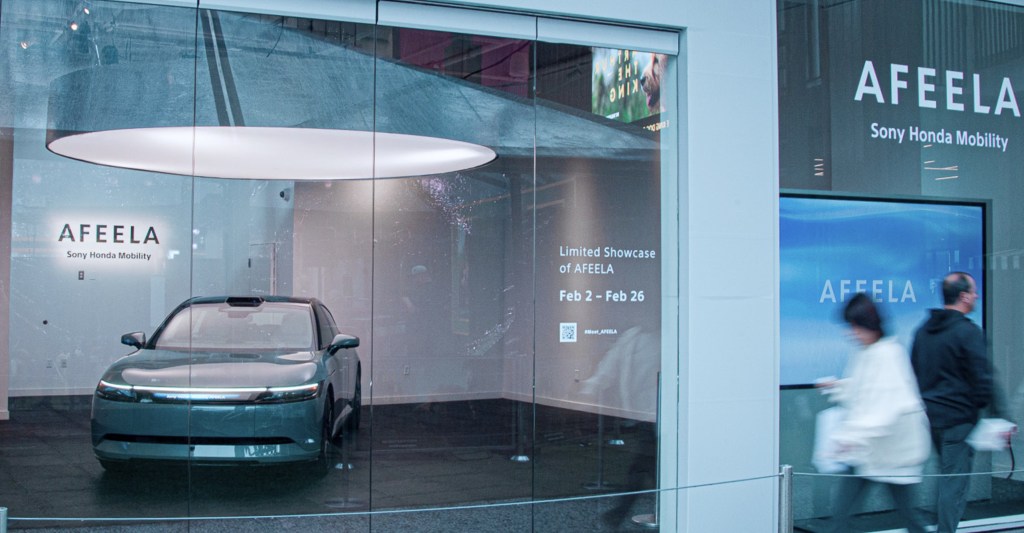Sony Honda Mobility shows off its cool Afeela electric car features | The DeanBeat

Sony Honda Mobility will ship its Afeela electric cars starting in 2026. But the joint venture company is already showing off cool features in the new vehicle.
I got a recent demo of the car and its driving simulator recently at Sony’s PlayStation headquarters in San Mateo, California. That’s where I got to see the uniquely Sony features on the new Afeela.
On the hood of the vehicle just above the bumper, there’s a “media bar” where you can read messages. The car’s media bar greeted me by name, “Welcome Dean Takahashi :).” You could pretty much program the media bar to show whatever you want, like “Happy Birthday.” You can put the Spider-Man logo on it and it shows up in lights.
The car also features advanced safety features like “AI for ADAS” and a way to show off your creativity with “Mobility as a Creative Entertainment Space” – under the theme of “Redefining the relationship between people and mobility.” For safety, the car is loaded with cameras that sense obstacles in the environment like pedestrians.
Lil Snack & GamesBeat
GamesBeat is excited to partner with Lil Snack to have customized games just for our audience! We know as gamers ourselves, this is an exciting way to engage through play with the GamesBeat content you have already come to love. Start playing games now!
Sony and Honda are also developing new entertainment and gaming features utilizing virtual space with Epic Games. Game developers can freely target applications and services that run on top of Afeela’s computing platform. Microsoft is developing a conversational personal agent, using Microsoft Azure OpenAI Service.
And Sony Honda Mobility is collaborating with Polyphony Digital, the game studio that makes the Gran Turismo car racing games to develop vehicles that fuse the virtual and the real. I got to play with the simulator developed by Polyphony Digital to simulate the tech in the vehicle.
AI for ADAS

The AI for ADAS makes use of sensing devices and AI. It features Vision Transformer for perception and machine learning for path planning. Also, a redundant system will be developed to secure safety. In this system, Qualcomm Technologies’ high-performance SoCs for automotive applications will be used.
This tool simulates external environmental conditions such as information for other vehicles, pedestrians, terrain, and weather. By combining this technology with AR, users will have an immersive experience that also enhances safety.
Sony Honda Mobility will provide a 3D map from which extensive metadata from the internet is overlaid. Map data can also be used to broaden the possibilities within the development of gaming and entertainment features.
To realize these features by incorporating sensing and vehicle data, Sony Honda Mobility uses the powerful gaming engine, Unreal Engine 5. The company uses the latest version, Unreal Engine 5.3, and will continue to implement updates for the latest Unreal Engine advancements. That is, you can update the car.
Speaking of safety, Sony and Honda are working on technology for coming up with a way so that the frontside passenger can watch a movie or play a game while the driver can’t see it or be distracted by it as well. I asked Raisu Williams, product specialist at Sony Honda Mobility, about whether the viewing angle will prevent someone from seeing the passenger display, but Williams said the company is working on it but isn’t describing it yet.
The entertainment space

Rather than rely solely on keeping the knowledge closed inhouse, Sony Honda Mobility will provide an environment where creators and developers can freely develop applications and services that run on Afeela, as well as a digital platform for co-creation and the expression of creativity.
The program includes a conversation personal agent, a deal with Microsoft to develop a conversational personal agent, using Microsoft Azure OpenAI Service.
Sony Honda Mobility will work with Polyphony Digital in vehicle development to develop vehicles that fuse the virtual and the real, mainly in the area of human senses and emotions by combining Polyphony Digital’s simulation technology with the development of actual vehicles by SHM.
On the outside of the car, the vehicle has LIDAR sensors for detecting your environment for self-driving features.
The car will features AR navigation where it shows you a line to follow in the environment on a turn-by-turn basis. The user interface is overlaid with AR.
The interior is pretty fascinating, scary and cool for gamers. There are cameras that point inward at the driver to see if you’re distracted using your phone or are sleepy. The AI kicks in to determine a course of action and proactively sends you alerts on the fly.
There’s a media bar with a display that extends from the dashboard on the driver’s side through a central console and the passenger side. It’s a continuous display.
The media bar on the outside is a way to send welcome messages to the driver or your passengers.
Opening the door

If you’re used to opening car doors, you’ll find this car is different. Akin to a Tesla’s door handle in terms of how confusing it can be. There is no door handle. There is a door button. You press it and the door will open. You can also open it with your smartphone.
Once you are in on the driver’s side, the seat and steering column will move to you. It uses its memory seating feature to adjust the seat to you. There was a welcome message for me on the display of the dashboard as well. For now, it can show an image. But in the future, there will be sound and lighting to greet you as well.

The main screen is dubbed a “panoramic” screen as it stretches from end to end, but can be subdivided into different sections. Sony tells me that the screen can help reduce driver distraction by making it easy to see all important information in front of me.
In the rear seat, there are screens for either backseat passenger. They can watch TV or movies, play games or listen to music.
Williams said the company is also currently working on a three passenger playback option, where all three passengers watch the same thing at the same time.
The steering is less a wheel than a “yoke.” It has a control system that looks familiar to gamers with buttons on either side of the center line. You can control the driver assistance functions in the buttons on the right. The pillars of Afeela include augmentation, autonomy and affinity.

Williams said the Afeela name is about being at the center of the mobility experience where the goal is to create a feeling. If you take that idea of creating a feeling, with augmentation, autonomy and affinity, you get a few a few of the design priorities.
Augmentation refers to customizing a vehicle to make it unique, Williams said. Say for instance, you had a favorite cafe. You could have a cafe listed on a screen with a map. You could zoom out or zoom in on the area, and you can change the theme and the ambient lighting. If you wanted, for instance, you could create a them around Sony’s Gran Turismo game or its PSVR 2 headset. Right now, the branding is based on Sony’s own games, but you never know what might happen in the future.
It was cool to see the ambient lighting change in the car to match the Spider-verse theme of Miles Morales. The lighting changes on the top of the car as well. The car has 360-degrees of spatial audio, so you can feel like you are in a surround sound field that is more like a concert venue than a car. If you roll the windows all the way up, people may not hear the music outside the vehicle.
The Afeela also comes with the Stingray Karaoke app which lets you belt out songs live in the car. And there is PlayStation Remote Play, which lets you connect remotely to your PS4 or PS5 game console and continue your games inside the vehicle in the back seat.
Autonomy and affinity

Eventually, Sony is shooting to hit Level 3 autonomy and Level 2 plus in a variety of situations. The car has cameras, sensors, processors and machine learning/AI. A lot of that is dedicated to improved safety and better recognition of conditions, people and vehicles. It can result in understanding the situation during bad weather. That can give drivers more peace of mind.
Affinity is the idea of working with creators and developers from all around the world. It’s giving you a platform in which you can create your own content and run it freely as you wish. Your car can help you express yourself and show off the things that you create.
The simulation

I didn’t get to drive the real Afeela, but I did get a sense for what it feels like to drive by driving the simulator, which has as much as the real car as possible in physical form and then virtual enhancements such as the screen that shows what it’s like to drive the car in the city. I drove the car and obeyed traffic laws — something I would never do in a PlayStation game — and I enjoyed myself.
The car is ready for presales now. I can tell it’s going to be a fine machine, particularly for gamers.













